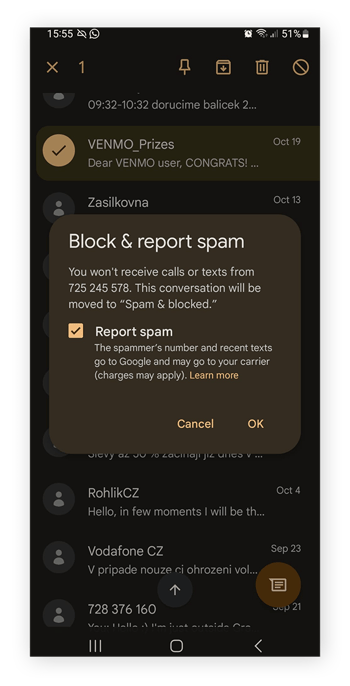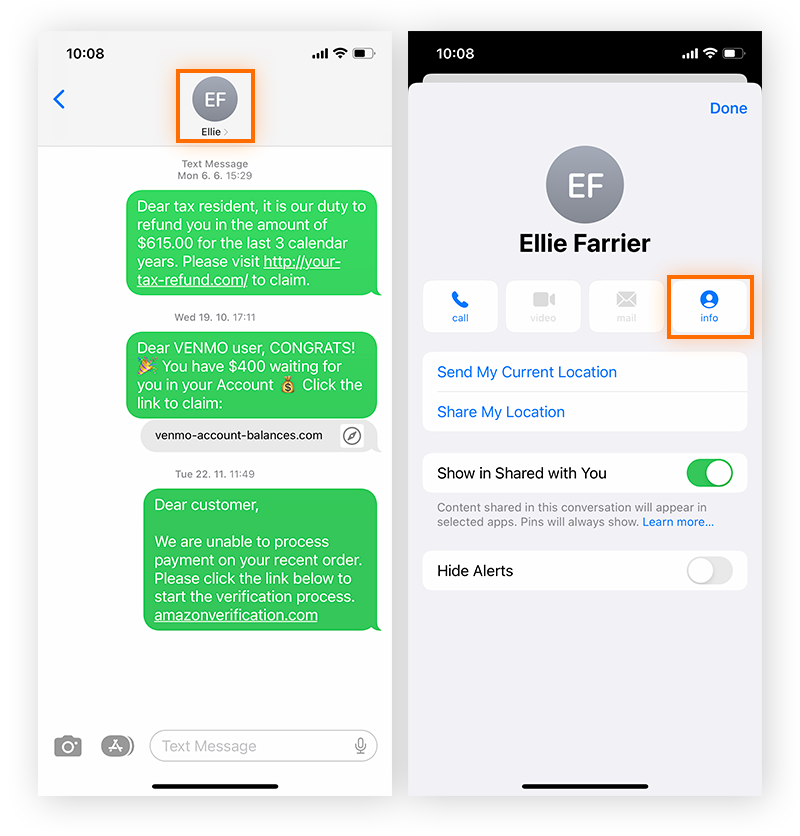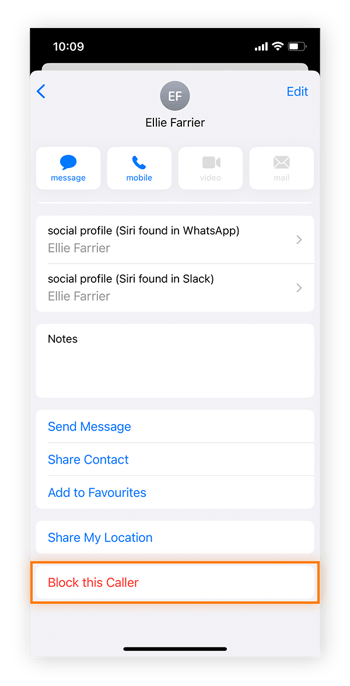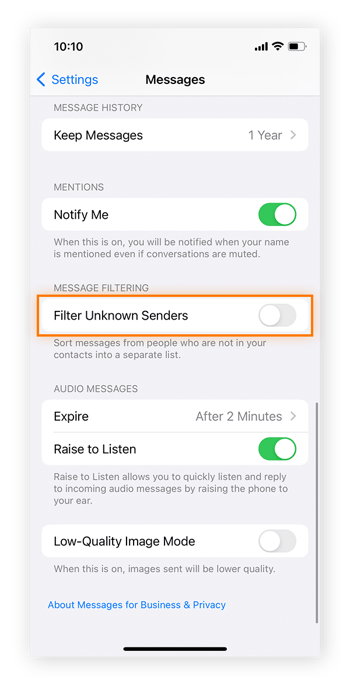Block malicious, spammy websites with Avast One
- Security
- Privacy
- Performance
Getting random text messages from unknown numbers is disturbing. But spam isn’t just annoying, it can also be a dangerous vehicle for malware. Keep reading to learn how to block texts, stop spam, and protect against other scam messages. Then get strong security software like Avast One to defend against spam, malware, and other online threats.
 (Academy)/How-to-stop-spam-text-messages-Hero.jpg?width=1200&name=How-to-stop-spam-text-messages-Hero.jpg)
Spam texts are unsolicited communications sent to mobile devices via SMS or instant messaging apps. Unwanted texts usually come from unknown numbers or as robotexts sent out in bulk by auto-dialers. Just like other forms of spam messages, spam texts often promote a product or service.

This Article Contains:
Spam comes in a variety of other forms, including spoofed phone calls from spam phone numbers as well as all the spam emails inundating our inboxes. Most spam messages are relatively harmless, and filtering out spam is usually simple. But while they usually don’t spread computer viruses or other malware, some spammers may be phishing for personal data or trying to scam you.
You could be getting spam messages because you’ve replied to spam texts in the past, called a toll-free number, or simply because some of the websites you’ve visited, signed up for, or ordered from have shared your personal info with data brokers.
Here are some reasons you might be getting spam text messages:
A public social media profile.
If your profiles are set to public on popular social media — like Facebook, Instagram, and LinkedIn — spammers can find your phone number and email there. Many social media sites have also been known to sell user data to third-party marketers.
Automatic-generation technology.
Spammers can use special technology to generate phone numbers in a specific range. Your number may periodically fall into these ranges, making you susceptible to receiving unsolicited spam text messages.
Automatic number identification (ANI).
Common toll-free numbers — such as 800 or 900 numbers in the US — use ANI to identify and collect incoming phone numbers. The data is mostly used for billing purposes, but can be connected to other parts of your digital footprint too.
Spammers have an almost-endless supply of annoying messages, schemes, and ploys. But most phishing messages — the kind of spam you need to watch out for — fall into one of a few categories.
Here are some of the most common examples of spam messages:
You’ve won!
Telling people they’ve won a random prize is a great way to get them to click a link — never mind that they never even entered a competition! These kinds of fake messages are almost always spam.
There’s a problem with your tax return.
Any text message purportedly about your tax affairs should ring an alarm. Real government agencies won’t contact you about unpaid taxes or rebates via SMS — only trust communications via certified mail, secure web-portals, or other appropriate channels.
You’re entitled to a refund.
Spammers know that people like cold, hard cash. That’s why they commonly use the prospect of a refund for an overpaid product or service to lure people into interacting with them.
Verify suspicious account activity.
Any unsolicited text trying to get you to verify an account should be a big red flag. If you think your account may have been hacked, change your passwords on the relevant website immediately and inform the company directly.
Package delivery failed.
It’s not unusual to receive text messages with updates about how and when an order or fake package will be delivered. But real logistics firms will never text you requesting personal details or money in order to complete the delivery.
Urgent! Help needed.
Fake or inappropriate messages supposedly from family and friends in need are another social engineering technique used by scammers and spammers. Take steps to verify any requests for money to help cover medical or financial emergencies, and if you believe someone is truly in danger, contact the authorities.
A phishing text message is a scam via text message that tries to fool you into providing sensitive information, such as usernames, passwords, or credit card info. Compared to typical marketing spam that may annoyingly advertise an offer or service, phishing texts usually aim to steal your personal data and use it against you.
Phishing attacks may also try to get you to install malicious software. Antivirus software will help prevent phishing attacks, keep your device and data safe, and get rid of spam messages in your inbox.
Robotexts are automated messages (robot messages) used by marketing spammers to send unwanted advertisements and other junk in bulk. Thankfully, you can block robotexts sent by bots in the same way that you can block other kinds of spam — directly in your messaging app.
Don’t interact with the text, except to block the number to prevent it from sending you more spam in the future. Then, report the spam text and spam phone number to alert your mobile carrier to the problem. Finally, use your phone’s built-in filtering and blocking features to shield yourself from all kinds of spam.
SMS bombing happens when people flood the inbox of a particular number with a torrent of SMS spam messages from apparently different numbers. Certan apps and websites specialize in SMS bombing, which can be difficult to stop given the sheer volume of spam texts.
Often starting as a prank, SMS bombing can go beyond prank status and into cybercrime — especially if it’s used as a cyberbulling technique. Built-in spam filters and third-party spam blockers can help stop SMS bombing. And you can also sign up to Do Not Text lists to unsubscribe from future spam and help prevent SMS bombing attacks.
You can block spam texts on most phones by opening the relevant messaging app, long-pressing the unwanted text, and tapping Report spam. Or, when the fake message is displayed on your phone, select the Options icon (3 dots) and select Block.
Here’s how to block spam texts on specific device types:
Here’s how to block unwanted spam text messages on your Android phone.
Open your messaging app and find the text you want to block. Long-press the message and tap the Block icon. (In some apps, you may need to tap Options (three dots) > Block.)

Tick Report spam, then tap OK.

Note that navigation may differ slightly for different Android manufacturers. Most Android phones have an option to enable spam protection against spam texts and calls in your device settings.
If you’re getting iPhone spam text messages, you can block them in a couple of different ways, making yourself less susceptible to future spam and phishing attacks.
Here’s how to block spam messages and unwanted texts on your iPhone:
Open the spam text message and tap the name of the sender. Tap the Info icon at the top of the screen.

Select Block this Caller.

Your iPhone can also filter out spam text messages on its own. Here’s how to block spam texts automatically:
Go to your iPhone’s Settings and tap Messages.

In the Message Filtering section, toggle the button for Filter Unknown Senders to on. Now any messages you receive from unknown numbers in iMessage or Messages will be collected in a separate list.

You can stop unwanted spam text messages in several ways. Ensure you never respond to spam messages, report spam whenever you receive it, or even install a third-party app to filter out spam messages. And, always block spam phone numbers to shield yourself from spammers and the online scams they perpetuate.
Here’s how to stop spam text messages:
No matter how annoying it is to receive random text messages from unknown numbers, do not respond to them. Responding to spam is one of the worst things you can do, because it lets the spammers know that your cell phone number is active, and you could invite a barrage of more robotexts and other unsolicited messages.
A simple way to stop spam texts from arriving in your inbox is to block spam numbers on your phone. This works on both iPhone and Android devices, and it prevents messages or calls from the blocked number from reaching you. Note that spammers may be able to bypass the block if they spoof someone else’s phone number.
Scammers may be getting smarter, but mobile service providers are also getting better at identifying and blocking spam phone numbers. Reporting suspicious texts or spam messages to your carrier helps protect yourself and others by preventing similar texting scams in the future. To report spam messages to AT&T, Verizon, or T-Mobile, forward the spam message to 7726.
You can also report a suspicious phone number and file a complaint with the relevant authorities in your jurisdiction. In the US, unwanted texts and internet scams can be reported to the Federal Trade Commission via the National Do Not Call Registry. You can also add your number to their Do Not Text list, which unsubscribes you from known spammers by banning them from targeting you.
For an extra layer of spam security, use an app to proactively block text messages from scammers and spam phone numbers. These apps draw upon enormous databases that are constantly updated to automatically block text scams and stop spam text messages from inundating your phone.
There are a range of built-in and third-party apps for filtering and blocking spam texts. And there are various organizations dedicated to investigating unlawful, inappropriate spamming and spoofing to which you can report spam texts and other potentially dangerous messages.
The best text blockers for Android don’t just stop spam text messages. They also include features like call silencing and spam recognition that can alert you to possible scams. For extra help in stopping spam texts, use an ad blocker for Android as well.
Here are three of the best spam-blocking Android apps:
Calls Blacklist
A complete call and SMS message blocking app, Calls Blacklist lets you block spam calls and text messages from both unknown and private numbers. You can also eliminate disturbances by blocking call notifications completely.
Key Messages
Key Messages is an AI-driven text message blocker for Android that automatically blocks spam messages from unknown senders. It’s fully MMS-compatible, letting you send multimedia content easily. You can block SMS messages based on categories, and you can back up your data to your Google Drive account.
Call Control
A comprehensive SMS blocker for Android, Call Control automatically recognizes and blocks spam calls and spam SMS messages. It also has a built-in incognito mode that lets you hide incoming calls and messages, and its smart screening feature automatically denies all confirmed and probable spam contacts. Plus, you can create personalized blocklists.
For an extra layer of protection on iOS, get a text blocking app for your iPhone. Effective at stopping spam of almost any kind, these top iOS text and call blockers get more powerful with each spam text report. Try an ad blocker for iOS to further protect against annoying disruptions on your phone.
Hiya
A feature-rich call and SMS blocker app for your iPhone, Hiya identifies spam calls, including robocalls and telemarketers, and blocks them automatically. You can easily view your blocked numbers and block spoofed spam calls by location (area code and prefix). Plus, its reverse phone lookup option helps you connect names to unsaved numbers.
TrueCaller
One of the largest and most-popular spam-blocking apps, TrueCaller has a 100% free subscription tier, while systematically stopping spam texts. Its database confirms the identity of any spam caller based on the experience of other people on its network, and it will stop the spam call before you answer.
VeroSMS
A dedicated SMS filter that puts your privacy first, VeroSMS lets you block texts by keyword or with region-based crowdsourcing data. VeroSMS doesn’t have access to your texts, and none of your data is sent to its servers. You can also customize your contact list, stopping outside callers while preventing verified contacts from being blocked.
SMS Shield
A machine learning spam filtering app, SMS Shield works online and offline to find and get rid of junk messages efficiently. Its manual control options let you stop specific SMS contacts based on keywords, while its AI engine easily identifies new and recycled spam. It also features a frequent traveler mode so you can block border-crossing SMS messages.
Don’t click on links in a spam text message or email. Spam text messages are a common vehicle for phishing scams that try to coax you into clicking links that lead to pharming websites, which aim to steal your data or inject adware or other malware into your device.
And verify a website's safety no matter how you get there — but especially if it’s via text or email. Ensuring you have a browser built for security and privacy set as your default browser can also help protect your data and stop spam from turning into something more threatening.
Legitimate companies won’t ask for sensitive personal information such as your address, account passwords, or government identification numbers via SMS. If you are asked to hand over personal data, report the spam text message immediately and take steps to block spammers sniffing around for your personal details. Without keeping your personal data private, you risk becoming a victim of identity theft.
Some spam advertising campaigns and other mobile scams force your cell phone to call or text premium numbers, which can run up your bill quickly. Review your mobile statements and look for any unusually high charges, unexpected data usage, or anything unusual.
Check your phone’s security settings and use any built-in privacy features like call blocking, caller ID, spam filters, and any other anti-spam controls to help stop unwanted text messages, spear phishing attempts, or other scams. These features will help you stop spam text messages.
Some spam may be harmless, but spam links and unsolicited messages can contain malware that will do real damage to your device. For an extra layer of protection against threats lurking in spam messages, Avast One is your solution.
Featuring AI-powered threat-detection technology, Avast One offers real-time protection against spam, malware, and other online threats, keeping your system and sensitive information safe. Available on both Android and iOS, it’s never been easier to stay protected against spam.
To block spam texts on your iPhone, go to Settings > Messages > Blocked Contacts and add the number you want to block. You can also report the message as spam by tapping on the message and selecting "Report Junk" or "Report as Spam."
When you block someone on Android messages, you essentially prevent their texts and calls from reaching you. Their messages won't appear in your messages app, you won't receive any notification, and if they call, your phone won’t ring.
However, the person you blocked doesn’t receive any notification or indication that they've been blocked. On their end, the messages and calls seem to go through normally, but you won't see or hear from them until you decide to unblock the contact.
Spam text messages, while annoying, can also serve as a pathway for malware. These messages may contain harmful links or encourage interactions that compromise your device's security.
Spam texts have been on the rise, following the trend of spam emails in previous years. In April 2021, individuals in the US received an average of 16.9 unwanted texts monthly. By April 2022, this figure dramatically increased to 41 spam messages per month.
The proliferation of smartphones, cheap bulk texting services, and the significant rewards available to successful scammers have all contributed to making this an attractive tactic for legitimate marketers and cybercriminals alike.
Spamming is not necessarily defined by the number of texts sent but rather by the content and intent behind them. A single unsolicited text promoting a product, service, or scam can be considered spam. Whereas multiple messages from a legitimate service that you've subscribed to would not be considered spam, even if they are frequent.
Yes, replying to a suspicious or scam text can potentially put your information at risk. Scammers often use texts to initiate phishing attempts, where the goal is to trick you into divulging personal or financial information. Even a simple response can confirm to the scammer that your number is active, leading to more targeted attacks.
Download free Avast One to block spam, malware, and other threats. Get real-time protection for your PC.
Download free Avast One to block spam, malware, and other threats. Get real-time protection for your Mac.
Install free Avast One to block spam, malware, and other threats. Get real-time protection for your Android phone.
Install free Avast One to defend against the malicious websites spammers love to use. Get real-time protection for your iPhone.
Block malicious, spammy websites with Avast One
Block spam and get real-time protection with Avast One